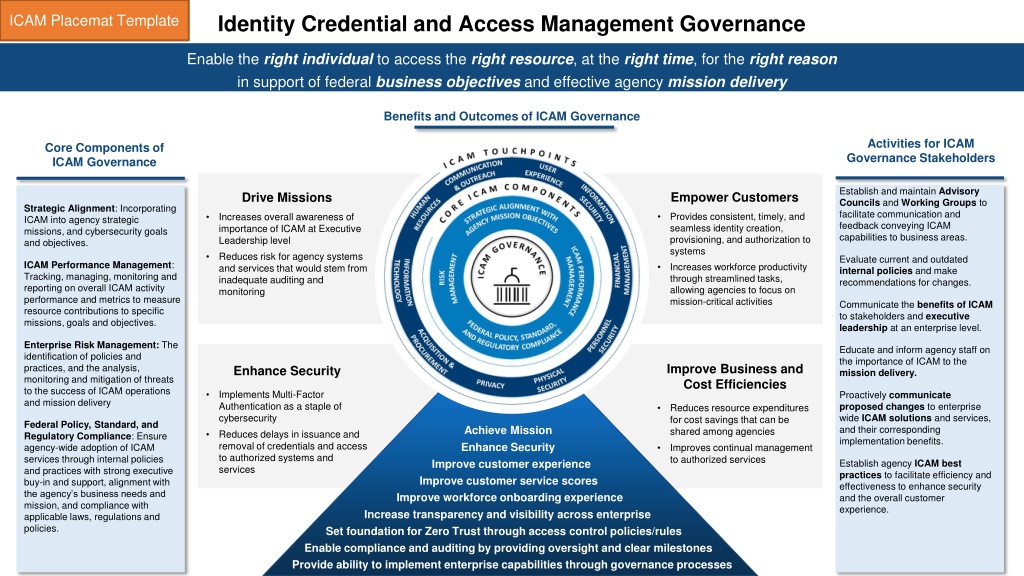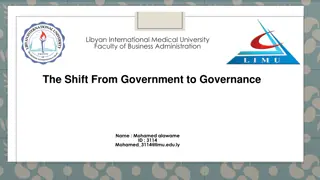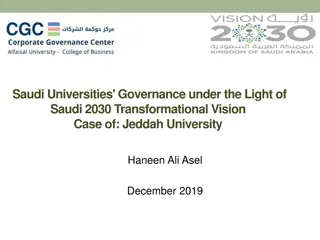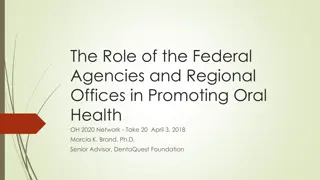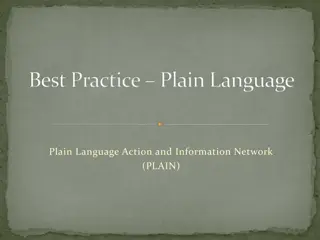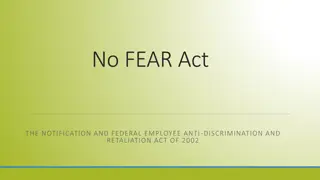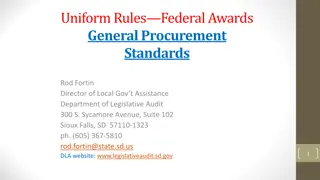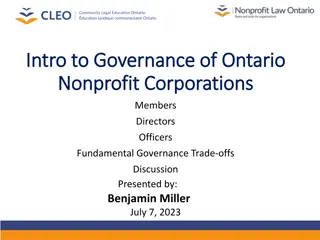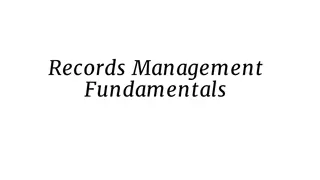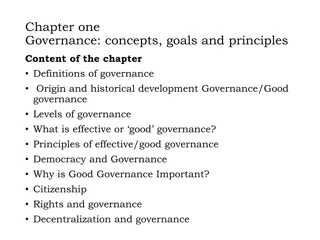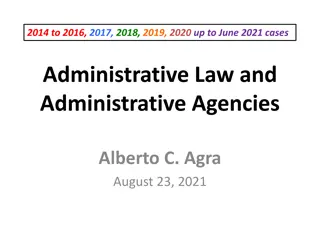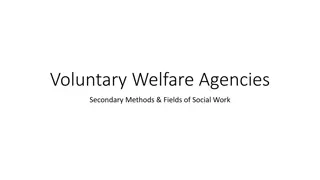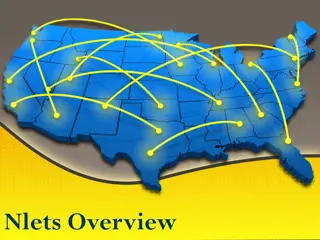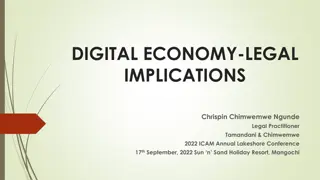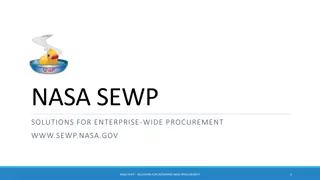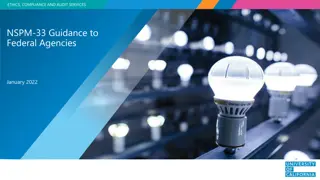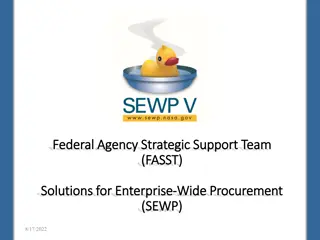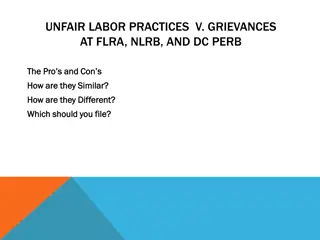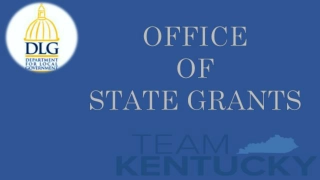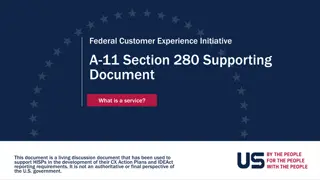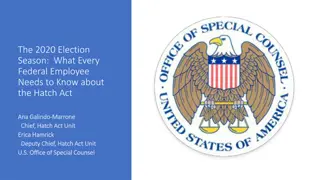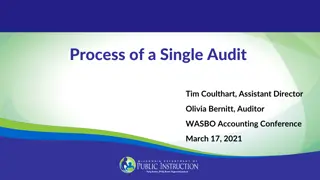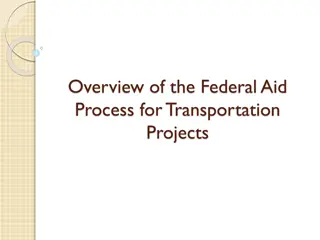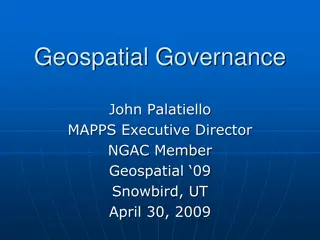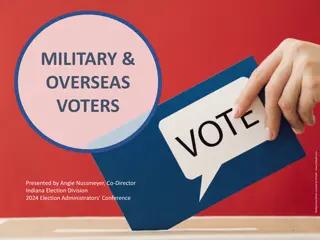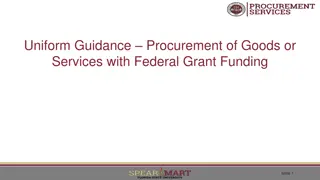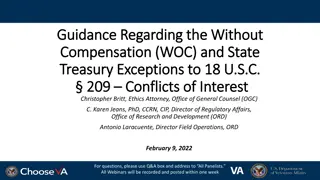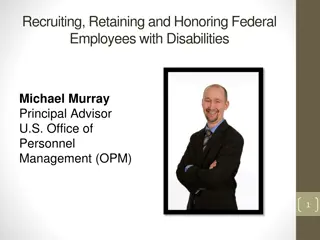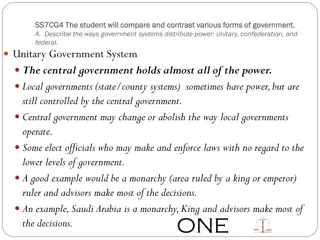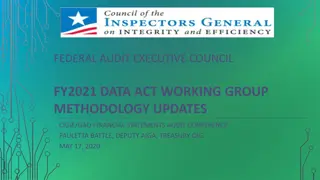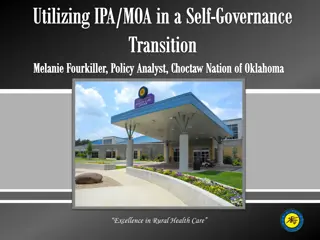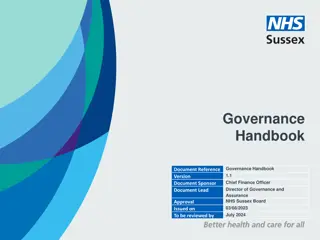Effective ICAM Governance for Federal Agencies
Enable secure access to resources with Identity Credential and Access Management Governance. Enhance security, streamline tasks, increase awareness, and comply with federal policies. Implement ICAM best practices, improve customer experience, and achieve agency missions efficiently.
Download Presentation

Please find below an Image/Link to download the presentation.
The content on the website is provided AS IS for your information and personal use only. It may not be sold, licensed, or shared on other websites without obtaining consent from the author. Download presentation by click this link. If you encounter any issues during the download, it is possible that the publisher has removed the file from their server.
E N D
Presentation Transcript
Identity Credential and Access Management Governance ICAM Placemat Template Enable the right individual to access the right resource, at the right time, for the right reason in support of federal business objectives and effective agency mission delivery Benefits and Outcomes of ICAM Governance Activities for ICAM Governance Stakeholders Core Components of ICAM Governance Establish and maintain Advisory Councils and Working Groups to facilitate communication and feedback conveying ICAM capabilities to business areas. Empower Customers Drive Missions Strategic Alignment: Incorporating ICAM into agency strategic missions, and cybersecurity goals and objectives. Provides consistent, timely, and seamless identity creation, provisioning, and authorization to systems Increases workforce productivity through streamlined tasks, allowing agencies to focus on mission-critical activities Increases overall awareness of importance of ICAM at Executive Leadership level Reduces risk for agency systems and services that would stem from inadequate auditing and monitoring Evaluate current and outdated internal policies and make recommendations for changes. ICAM Performance Management: Tracking, managing, monitoring and reporting on overall ICAM activity performance and metrics to measure resource contributions to specific missions, goals and objectives. Communicate the benefits of ICAM to stakeholders and executive leadership at an enterprise level. Enterprise Risk Management: The identification of policies and practices, and the analysis, monitoring and mitigation of threats to the success of ICAM operations and mission delivery Educate and inform agency staff on the importance of ICAM to the mission delivery. Improve Business and Cost Efficiencies Enhance Security Implements Multi-Factor Authentication as a staple of cybersecurity Reduces delays in issuance and removal of credentials and access to authorized systems and services Proactively communicate proposed changes to enterprise wide ICAM solutions and services, and their corresponding implementation benefits. Reduces resource expenditures for cost savings that can be shared among agencies Improves continual management to authorized services Federal Policy, Standard, and Regulatory Compliance: Ensure agency-wide adoption of ICAM services through internal policies and practices with strong executive buy-in and support, alignment with the agency s business needs and mission, and compliance with applicable laws, regulations and policies. Achieve Mission Enhance Security Improve customer experience Improve customer service scores Improve workforce onboarding experience Increase transparency and visibility across enterprise Set foundation for Zero Trust through access control policies/rules Enable compliance and auditing by providing oversight and clear milestones Provide ability to implement enterprise capabilities through governance processes Establish agency ICAM best practices to facilitate efficiency and effectiveness to enhance security and the overall customer experience.
ICAM Touchpoints Template T O U C H P O I N T S &OUTREACH I C A M C O R E I C A M C O M P O N E N T S ICAM GOVERNANCE COMMUNICATION USER EXPERIENCE INFORMATION SECURITY RESOURCES HUMAN STRATEGICALIGNMENTWITH AGENCYMISSIONOBJECTIVESICAMPERFORMANCE MANAGEMENT MANAGEMENT FINANCIAL MANAGEMENT INFORMATION TECHNOLOGY RISK FEDERAL POLICY, STANDARD, PERSONNEL AND REGULATORY COMPLIANCE SECURITY ACQUISITION & PROCUREMENT PHYSICAL SECURITY PRIVACY
ICAM Touchpoints Static Image
Basic Journey Map Template: Agency Journey Map Select & Implement Cyclical approach to stabilize, enhance and optimize processes & controls to account for updated federal regulations and/or business enablement requirements Setup Reporting, Dashboard & KPI metrics Draft Policies & Procedures that facilitate adoption Define Future Vision Current State of ICAM Capability Socialize approach across Agency Assess & Analyze Build foundation al blocks Key drivers Create High Level Technical Roadmap - Agile Plan & Design
Example: Agency Digital Identity Journey Map Understand business and technical requirements as well as a detailed awareness of the options available within the market Review agency understanding of the processes in use today and Categorize and identify opportunities for consolidation and automation. Build the Case - outline internal or external factors causing issues, identifying specific behaviors that must change, clarifying the impacts of not changing, and outlining a roadmap with measurable success criteria. Review authoritative source integration for enhancement opportunities while developing an implementation strategy Select deployment options - Full service or componentized Confirm and document agency s understanding of current processes and the tools used to support them, Identify overlaps between program needs to avoid duplication of efforts. Identify key stakeholders who could be affected by the selection and implementation of an enterprise-wide identity service. Standing up working group / committee to meet regularly and share progress Select & Implement Review current policies and draft updates to the policies for the new digital identity approach Set up governance structure to ensure organizational change and enterprise solution; Development requires well defined governance, cross-program involvement and multi-team collaboration to be successful Review of existing architecture and infrastructure supporting targeted agency applications including identity proofing, authentication, federation, and identity management technologies. Formalize policies throughout enterprise and engage in change management to increase adoption Define success metrics and milestones to track progress towards project success. Cyclical approach to stabilize, enhance and optimize processes & controls to account for updated federal regulations and/or business enablement requirements Setup Reporting, Dashboard & KPI metrics Draft Policies & Procedures that facilitate adoption Define Future Vision Current State of Digital Identity Socialize approach across Agency Assess & Analyze Build foundation al blocks Key drivers Understand Key Performance Indicators (KPIs) and how to track them Review of existing tools and technologies used to support identity proofing, authentication and authorization of users along with federation capabilities. Interim: This will focus on an interim state where agency will leverage current technologies potential products that can be easily integrated with currently owned technology and acknowledge potential regulatory changes that may be required to support integration of processes. End state: The end state implementation will look beyond current constraints and include recommendations for improvements to both technology and processes while focusing on innovation and scalable and feasible solutions for offering a shared service. Securing User data protect Customer and Workforce users from fraud and identity theft in an environment of evolving threats and attack vectors. Create High Level Technical Roadmap - Agile Plan & Design Create Reports to monitor progress and development of digital identity strategy Empowering Users & moving to Digital Digital Identity solution will allow users to further protect sensitive data and ensure compliance with electronic authentication guidelines. Design path forward and future vision of Digital Identity approach Define deployment options of the digital identity strategy Technical roadmap will include customizability to allow for future agile updates Plan working group requirements gathering sessions to capture technical and functional requirements Produce periodic reports/metrics for stakeholders to make strategic decisions Assess working group current state assessment and future vision Analyze a path forward on current state assessment and future vision. Embed activities associated with stabilize, enhance and optimize in the future vision. Complying with Federal Guidelines - Review of associated policies and regulations for their impact on future business entity identity assurance and validation processes. Technical roadmap will integrate the current state and future intended digital identity state Agency will identify necessary resources to be procured to achieve the intended digital identity state Design initial solution recommendations including strategic, business, and technical outputs Assess and analyze the fundamental drivers of project success, defining interventions to successfully manage stakeholders, and ultimately enabling the highest levels of end-user adoption Detailed Journey Map Technical roadmap will incorporate user experience & transparency to ensure a seamless transition for end users
Word Cloud Option 1 Improve Digital Services Improve Regulatory Compliance Mitigate Risk Empower Customers ICAM GOVERNANCE Strategic Alignment Protect Identity Data Advance Zero Trust Security Improve Accountability Enterprise Risk Management Improve Workforce Productivity Mission Achievement BENEFITS Improve Audit Response Performance Management Support Modernization Efforts Federal Policy, Standard, and Regulatory Compliance Enhance Security Efficient Use of Resources Reduce Operating Costs Improve User Experience Improve Cost Efficiency
Word Cloud Option 2 Increase consumer confidence in agency services Improve audit responses ICAM GOVERNANCE Strategic Alignment Improve cross-agency collaboration Enterprise Risk Management Enhance mission delivery BENEFITS Performance Management Federal Policy, Standard, and Regulatory Compliance Improve personnel security Improve physical security Improve regulatory compliance
Communication and Outreach User Experience Strategic Alignment ICAM Program Management Playbook Example Performance Metrics Elevator Pitches | Placemats Word Clouds Budget talking points Journey Maps Value Propositions Elevator Pitches | Placemats Journey Maps Word Clouds ICAM Program Management Playbook Business Case/Return on Investment Program Charter Example Performance Metrics ICAM Strategy Internal ICAM Policies ICAM Vision Statement Human Resources Performance Management Example onboarding processes Journey Maps Word Clouds Elevator Pitches | Placemats ICAM Primer / 101 ICAM Program Management Playbook Example Performance Metrics Service Level Agreements (SLAs) Information Security, Financial Management, Physical Security, Personnel Security, Privacy Enterprise Risk Management ICAM Strategy / Policy IT Strategic Plan Risk Register Elevator Pitches | Placemats Word Clouds Journey Maps ICAM Primer / 101 Information Technology Elevator Pitches | Placemats Word Clouds Journey Maps ICAM Primer / 101 Acquisition & Procurement Federal Policy, Standard and Regulatory Compliance ICAM Acquisition Guidance FITARA Review triggers ICAM Primer / 101 ICAM Policy/Strategy Example Performance Metrics Gap Analysis Template ICAM Governance Tool
